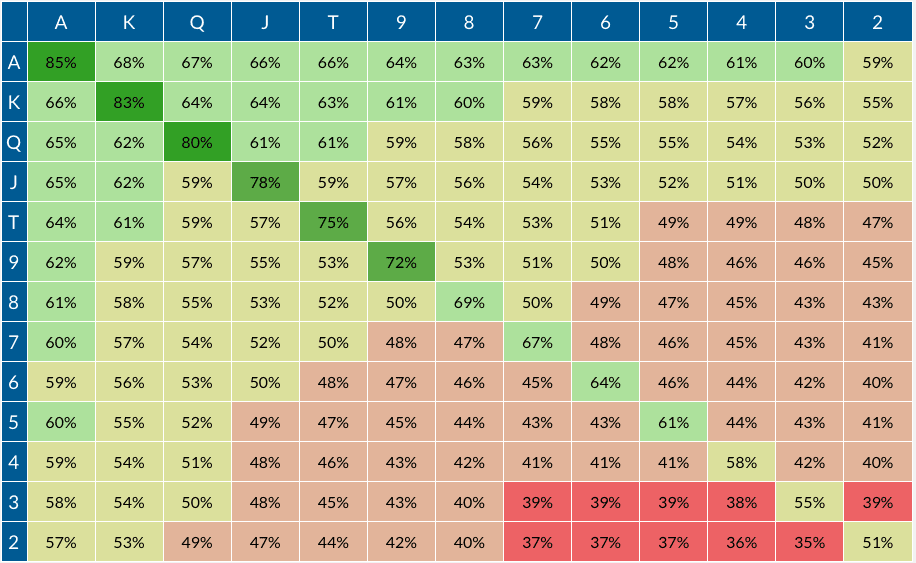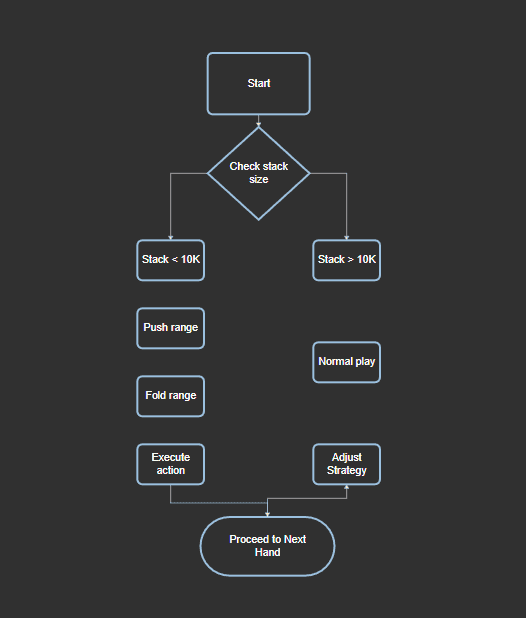
MTT Poker Bot: Dance of Algorithms and Bluffs
Anybody I say that to, I figure they envision some flashy, movie-like casino scene-smoking rooms, low lights, some guy with a hoody on counting cards with some computer tucked underneath the table. Reality-the back of a desk, sunlit room, here in Thailand, perfecting algorithms that would give the average casino patron a headache. I call it my ‘digital tango with probability’.
That dance does not get more intricate anywhere than in MTT poker, or Multi-Table Tournaments, really-the unique beast that one minute you’re the king of the chip stack; hanging on for dear life with a stack of chips smaller than your morning espresso, the next. It is a game of survival, patience, and calculated aggression-poetic, right? Until you are starting to program a bot to master it.
Want to know how our poker bot works? Visit our Knowledge Hub.
MTT: The Madness and the Beauty
Let’s get it straight: everything that makes a Texas Hold’em game is similar, from the two hole cards down to five community cards, trying to outsmart everybody else on the table; but MTTs cruise on a different frequency altogether. They are more the marathon, not the sprint. Hundreds, at times thousands, of players start with the same stack, dream of those juiciest top prizes. The structure is non-negotiable: the blinds keep on going up, and you are forced to play. You can’t just sit back, wait for pocket aces, and hope for the best.
Now, to translate all that chaos into a piece of software-that’s the real kick. A MTT poker bot is all about calculating the odds, but it does take in a lot of timing, grasping table dynamics, knowing when to push, and knowing when to fold. Of course, the latter does involve some element of bluffing. Can a bot bluff? You bet it can. Just don’t expect it to break into a sweat while it does it.
MTT Bot Building: Where Math Meets Mind Games

It’s like you may be asked to play chess, but they change the board on you all the time. And sometimes that’s stronger than any knight; it’s better to take and throw a water balloon at your opponent. That’s how making this MTT bot feels. The mathematics of poker, the probabilities, game theory-all that beautiful equations I was studying in Moscow State University and then brought up to perfection in MIT-they are merely a starting point.
My bot combines game theory optimal strategies with something more human: the so-called exploitative play. In GTO, one looks for a strategy just not to be exploited by opponents, regardless of how they play. It is like speaking in a tongue nobody can quite understand but can’t argue with, either. Clean, elegant, and, frankly, a little bit cold.
But MTTs aren’t a purely GTO game. They’re fluid, and they change along with the rise of the blinds and the falling numbers of the players. That’s where the exploitative play kicks in-you find the weakness and patterns in other people’s bets that you can exploit. Like when you notice this guy across the table raises anytime he thinks nobody is watching.
You call his bluff, and in an instant, he is as nervous as a cat in a room full of rocking chairs.
Practicalities: Preparing Your Bot for Competition
Alright then, how would setup a bot that could survive both in the chip jungle and on bad beats? Let’s get to the brass tacks.
- Database and Data Analysis:
- A successful MTT bot starts with a database of hand histories: You feed it thousands, even millions, of hands and let it analyze the patterns. How often do players raise with a certain hand? What range of hands are they likely to have when they 3-bet? That’s the kind of thing your bot must figure out if it’s to make an informed decision.
- One of the more significant analyses, for example, is to understand position play. Through this game, a bot learns that players actually fold way too much to big-blind raises and thus adjusts his aggression with the aim of stealing more blinds from late position, something very vital during a tournament when the blinds happen to be huge in relation to the size of stacks.
- Pre-flop strategy libraries
- One could envision an MTT bot’s preflop strategy as a sound foundation upon which everything else is built. In most of them, these will be programmed in as libraries of range by situation: early position, middle position, late position, small blind, and big blind.
- Suppose for a second that your bot is in a late position and gets a small blind limp. Its library can include raising 50 percent of the time with marginal hands-to take advantage of any passivity on the part of the small blind player-for example, suited connectors-9♠ 8♠. It is only a slight adjustment to the pre-flop code, but one which would make quite a big difference for the bot in key spots.
- ICM (Independent Chip Model) Calculations:
- Anything is less important than stack sizes in the later stages of a tournament. And that is where ICM steps in-the calculation of each stack size’s equity with regard to payouts. Here, the bot needs to understand the value of one chip with respect to the prize structure of the tournament.
- A very simple example would be that the bot is on the button with pocket 7s, having 12 big blinds remaining, and he needs to choose whether to shove or fold. ICM says it’s a wee higher expected value in pushing all-in, taking into consideration the payout structure and probable ranges of the opponent, compared to those resulting from folding. These types of calculations enable the bot to make optimal long-term profitability choices.

Bluffing and Semi-Bluffing: Programmed to Fool
Bluffing is that magic word that makes poker far beyond the cards; it’s about reading minds-a psychological game-one has to be inside of one’s head. What would happen if instead of the head you’d put a machine? Building the MTT bot, you simply can’t refrain from asking yourself a question: Can a machine bluff?
The short answer is yes, but not quite the way you might think.
Perhaps he’s on a weak draw-something like a backdoor flush draw on a rainbow board. He knows that a bet in this spot, even with a weak hand, might make his opponent fold if he’s holding two overcards. This is one variety of semi-bluff, where he’s betting with a hand that could improve on later streets, but might win the pot outright if his opponent folds. Concretely speaking, for all possible opponent responses, the bot strategy computes probabilities over check, bet, and raise. If the fold equity computed is larger than the check value, then it is time to fire a bet from the bot’s side. Brutally effective, yet far from emotional.
The Real Challenge: Surviving the Variance
But let’s not get too romantic here: with building a bot for MTTs comes a dark side in the name of variance. The best player in the world-human or machine-can lose hundreds of hands in a row just because he had really bad luck. In tournaments, when your whole stack can disappear on a single hand, that bad luck just feels like a gut punch.
You spend months building a bot to play perfect, widening its ranges, and pushing at just the right times, and then some guy across the screen catches a miracle river card and poof-your bot is out. It’s infuriating, it’s humbling, and in some strange way, it’s beautiful.
To mitigate this, I’ve coded a “tilt-proof” feature.

The complete opposite of a frustrated human who is on a bad beat series and who starts overplaying hands, this automatically readjusts in its playing and recalculates with updated stack sizes and remaining time in the tournament. If the chip stack of the bot, for example, gets below 10 big blinds, he changes into a push-fold strategy by going all-in with a defined range including suited aces, pairs, and strong broadway cards. It’s kind of a failsafe for when the chips are down, which makes the bot go aggro.
Beyond the Numbers: The Future of MTT Poker Bots
You might then wonder: if bots like mine keep improving, what becomes of the game? Some sort of dystopian future in which MTTs become a struggle of the bots, and the humans are on the stands, something like a cybernetic gladiatorial combat? Tempting, but poker is nowhere near going anywhere. Sure, high-stakes online gaming has its share of bot-driven drama, but humans are wild cards-unpredictable, emotive, and prone to making irrational decisions in ways no bot will ever replicate. People love playing poker for reasons other than the money-for the feel of reading a player’s face, heart-racing all-ins, when a bluff gets called and you flip over your cards, holding your breath. But no matter how good that sounds, a bot can’t experience that thrill. And that’s beautiful, sort of-to know that no matter how fine my code gets, there will always be room at the table for the unpredictable, the chaotic-the human.
